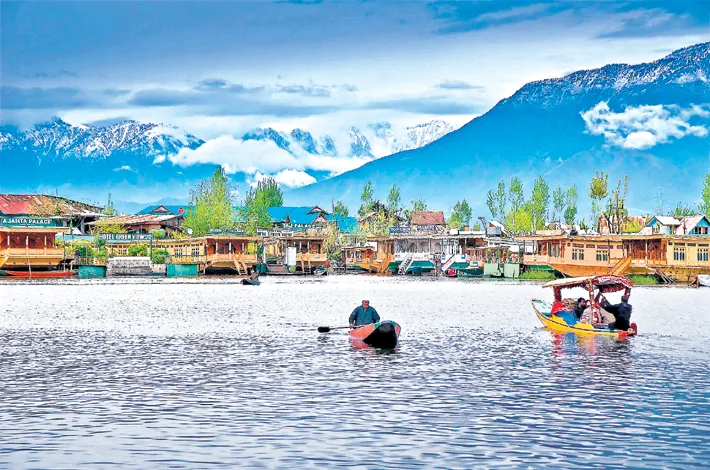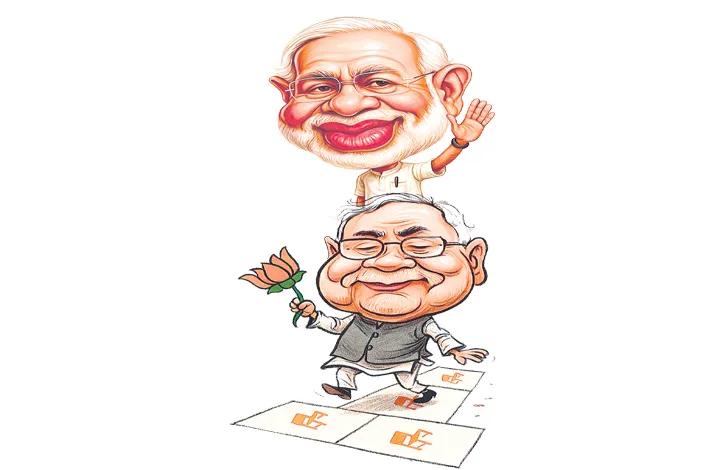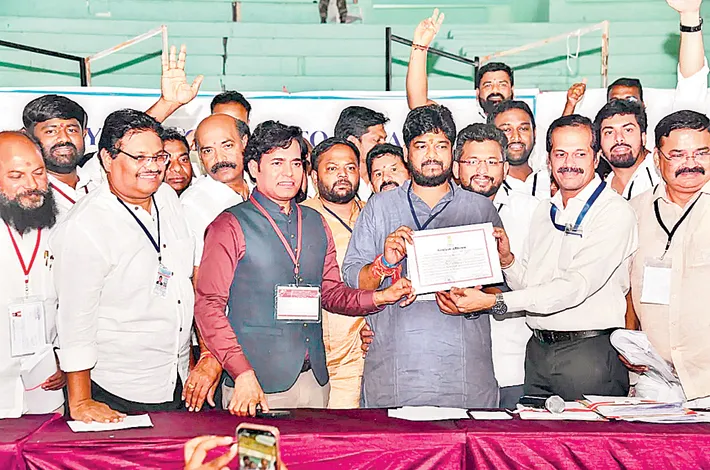Kashmir Merger Only Due to Nehru
14-11-2025 12:00:00 AM

Venkat Parsa
Pandit Jawaharlal Nehru is targeted for his greatest achievement, integration of Jammu & Kashmir with India. Merger of Jammu & Kashmir became possible only due to Nehru. But for Nehru, no one else was either interested, or competent, to achieve this seemingly unachievable goal.
India was not a republic yet and Lord Mountbatten was still the Head of the Government, as the first Governor-General of India and the Army Chief was still a Britisher. Britain was soft on Pakistan. Creditably, Nehru managed to navigate his way through this minefield and achieved the unthinkable.
Most importantly, Jammu & Kashmir did not join India at the time of the Indian Independence, along with the other States. At that time, Maharaja Hari Singh had already signed Standstill Agreement with Pakistan and, for him, joining Pakistan was an option.
Finally, Jammu & Kashmir joined Indian Union through the Instrument of Accession, signed on October 26, 1947, two months after Indian Independence, on the insistence of Pandit Jawaharlal Nehru.
A common refrain is that if Sardar Patel was the first Prime Minister of India, instead of Pandit Jawaharlal Nehru, Kashmir problem would not have arisen. And that Nehru had committed monumental blunder, by going in for Article 370 in the Constitution, not going in for complete annexation of Jammu & Kashmir and internationalization of Kashmir, by taking it to the United Nations Security Council.
Fallacious Assumptions
The entire set of assumptions, prompted on WhatsApp University, are fallacious and far removed from facts. Sardar Patel piloted Article 370 in the Constituent Assembly, as Nehru was away from India, travelling abroad and it had the consent of Patel.
Nehru did not have fiefdom over the issue of Jammu & Kashmir. As Deputy Prime Minister and Union Home Minister, it was Sardar Patel, who worked out the nitty-gritty of the Kashmir Policy formulated by Jawaharlal Nehru.
Another key player, V P Menon, Secretary of States, was working in the Home Ministry, directly under Sardar Patel. In fact, the entire process was carried out under the superintendence of Sardar Patel.
If Nehru devised Article 370 in 1947, by 1953, he set in motion the process of ending the Special Status, to fully integrate the State into India. Indira Gandhi completed the process of making Article 370 a Dead Letter, as it triggered a series of demands, right from the Indira-Sheikh Accord in 1975 for restoration of Autonomy.
As for beating back Pakistani aggression, Indian Army was in the hands of a Britisher. Governor-General Lord Mountbatten, with soft corner for Pakistan, was personally overseeing the operations. Indian Army division, following Partition, was not complete. Arms and ammunition were inadequate at that time, which continued till during the Chinese attack on India in 1962.
In a swift operation, Nehru secured Kashmir Valley, hailed as Jannat-e-Benazir, before Britain could fully comprehend what was happening on the ground. Demographic profile changed in the rest of Kashmir and it did not really matter.
Nehru's UN Gambit
On January 1, 1948, Nehru moved United Nations Security Council under Article 35 of the UN Charter. The demand was for vacation of Pakistani aggression on the Indian State of Jammu & Kashmir. If someone lodges complaint with the police on the loss of wristwatch, it only strengthens ownership of the watch and nobody, in right senses, could object to it, saying, why did you make it public?
The UN Security Council passed Resolution 47, in April 1948, which calling for ceasefire and withdrawal of Pakistani forces from the Indian soil. India had got Jammu & Kashmir through the Instrument of Accession, which strengthened her case on Kashmir.
In fact, initial UN Security Council Resolutions were all in favour of India. It was only with the onset of the Cold War that the situation changed, with altering of geo-political equations. That was when the United States and Britain realized they needed a NATO foothold in South Asia and decided to side with Pakistan.
At the first opportunity, Indira Gandhi deftly took away Jammu & Kashmir from the UN purview and put it in bilateral format, through the Shimla Agreement with Pakistan President Zulfiquar Ali Bhutto on July 2, 1972. In fact, P V Narasimha Rao refused to go in for Second Nuclear Tests in Pokhran in 1995, for strategic reasons. Advanced technology was available for computer-simulated tests, rendering physical tests redundant. And for geopolitical reasons.
When BJP came power in 1998, Prime Minister Atal Behari Vajpayee had to prove himself and ended up doing the tests. As a result, Kashmir got internationalized really, for the first time.
Mountbatten Plan
Mountbatten Plan of June 3, 1947, was basis for the Indian Independence Act passed by the British Parliament. Lord Mountbatten cleared Partition of Punjab and Bengal on religious basis. It specified that Hindu-majority areas go to India and Muslim-majority areas go to Pakistan.
Yet, Muslim-majority Jammu & Kashmir merged with India, which was well-nigh impossible. What seemed to be nearly impossible, was finally achieved by Nehru through the Instrument of Accession.
Jawaharlal Nehru joined hands with National Conference leader Sheikh Abdullah to mobilize the vast masses of people in Kashmir Valley. The people wholeheartedly supported the move of Jammu & Kashmir joining the Indian Union. Instead of annexing Kashmir by force, Nehru adopted the democratic way of reaching out to the people, which paid him rich dividends, ultimately. People of Jammu & Kashmir were pro-India.
Instrument of Accession
Sheikh Abdullah piled up pressure on Maharaja Hari Singh, who signed Standstill Agreement with Pakistan. In fact, Pakistan, itself, did not stake claim to Kashmir; which is why, it camouflaged Pakistani Army as tribal raiders, to attack Kashmir Valley on October 22, 1947.
Maharaja Hari Singh fled the Valley and reached Jammu, at the time of Pakistani attack. Startled by Pakistani attack, Maharaja Hari Singh petioned Nehru. But Nehru insisted on the Kashmir Ruler first signing the Instrument of Accession.
After Hari Singh agreed, V P Menon was rushed by Special Aircraft with Draft Instrument of Accession to Jammu.
After Hari Singh signed the Instrument of Accession on October 26, 1947, V P Menon returned to Delhi. Then the Cabinet met to endorse it and to decide on airlifting Army to Srinagar to push back Pakistani attack.
Why Article 370?
Since Jammu & Kashmir merger was through the Instrument of Accession, it was on special terms. At that moment, focus was more on facilitating Kashmir merger achieved under the lens of Lord Mountbatten.
It was against this background that Article 370 assumed significance. Indeed, Article 370 became the bridge between Jammu & Kashmir. Now, snapping the connecting bridge cannot be made out into an achievement.
Article 370 became a Dead Letter in the Constitution. Then came Abrogation of Article 370. This was another sheer act of bravado, for political consumption, with no difference being made on the ground.
Drama on Autonomy
In fact, up to 1953, Jammu & Kashmir enjoyed tremendous autonomy. Governor Karan Singh was called Sadar-e-Riyaasat and Chief Minister Sheikh Abdullah was known as Wazir-e-Azam. Jammu & Kashmir had its own flag and Constitution, which was finalized in 1956 and adopted in 1957. Turning point came in 1953. Sheikh Abdullah was dismissed for his anti-national activities and for Kashmir Conspiracy Case and he arrested and put in jail.
Bakshi Ghulam Mohammad replaced Sheikh Abdullah. Under the Jammu & Kashmir Constitution, none of the Indian institutions were applicable. The successive Congress Governments progressively extended the jurisdiction of various institutions was extended to Jammu & Kashmir through the Presidential Application Orders. The Congress, which brought in Article 370, was also responsible for virtually making it toothless and thus completely made it meaningless.
Indira-Sheikh Accord
In fact, Indira Gandhi-Sheikh Abdullah Accord in 1975 was worked out for bringing about political settlement by rehabilitating Sheikh Abdullah as Jammu & Kashmir Chief Minister. Syed Mir Qasim, the Congress Chief Minister, stepped down to make way for Sheikh Abdullah in Srinagar. At that point, Sheikh Abdullah needed a face-saver in the form of assurance to restore autonomy to Jammu & Kashmir.
Indira Gandhi-Sheikh Abdullah Accord in 1975 remained on paper. Later, Sheikh Abdullah's son, Dr Farooq Abdullah, joined BJP-led NDA under Prime Minister Atal Behari Vajpayee in 1999 and Dr Farooq Abdullah's son Omar Abdullah became Union Minister of State, including in the Ministry of External Affairs.
At that time, again as face-saver, Dr Farooq Abdullah enacted a drama of passing Autonomy Resolution in the State Assembly in June, 2000, and sent it to the Centre. Vajpayee Government immediately held a Cabinet meeting to reject the Jammu & Kashmir Assembly Resolution, demanding Greater Autonomy. It was all according to script and expectedly there were no fireworks.
Nehru was human and fallible. But no one can doubt his intentions and question his integrity. Against odds, Nehru secured Kashmir for India and it is among his monumental achievements.








